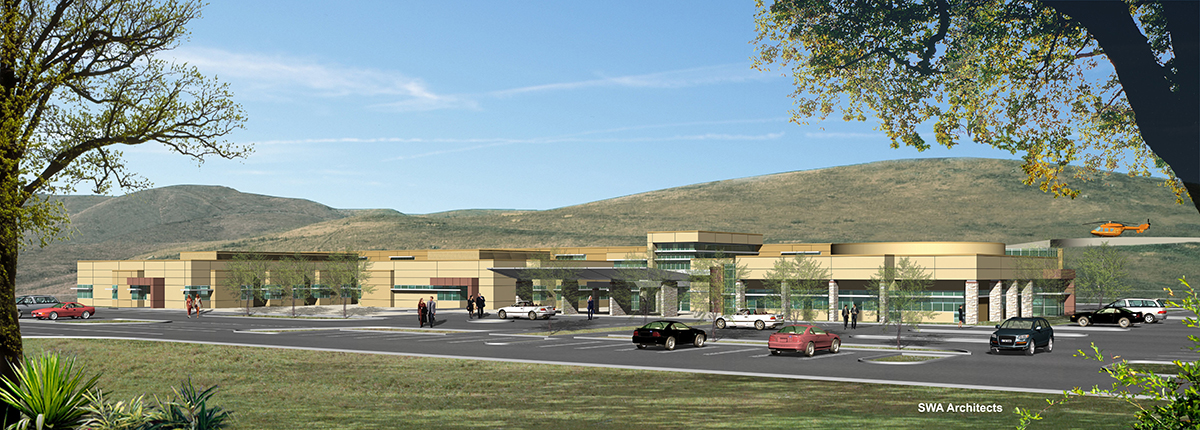Bernards, a well-respected, nationally ranked construction firm and Colombo Construction Company, a southern California firm known for its quality healthcare projects, have teamed for the first time to provide construction management services for the $57 Million Tehachapi Valley Healthcare District Replacement Hospital in Tehachapi, California. This new 25-bed, 79,000 square foot facility will replace the existing hospital which no longer meets current California safety standards, and is located in a rural part of Kern County. As the only hospital in a 50-mile radius, the project is a vital addition to the community, so it’s important that the team completes the job as quickly and efficiently as possible.
Challenge
The project broke ground in early 2013, and the first challenge the team faced was how to manage the enormous number of drawings necessary for the construction of a hospital. Since Tehachapi is a California hospital, it requires approval from the Office of Statewide Health Planning and Development (OSHPD*). Because of time constraints during the bidding process, two sets of drawings had to be correlated: a “permit set” of 500 documents for OSHPD approval, and another “bid set” of 520 documents for the prime contractors.
Not only was the bid set larger, but it also contained updated information that was not reflected in the older permit set. The team needed a reliable solution to quickly and accurately compare the differences between the two versions. Printing hard copies of each set and comparing them against each other was not an option — the process would be time-consuming and risk a significant margin for error. Moreover, because of the project’s remote location, printing costs are extremely high. It was becoming clear that digital was the only way to go.
A Digital Solution
The team at first considered looking for a third-party service to help with the seemingly overwhelming task of comparing the two sets of drawings. Fortunately, Bernards Project Engineer William Lopez had a better idea. Having used Bluebeam Revu on other projects with great success, he was confident that leveraging Revu was the best course of action. The technology was already in-house, and this solution saved time and the cost of looking for a third party qualified enough to complete the work.
The Tehachapi team contacted the project architect, requesting PDF copies of both the permit and bid sets. They then began the process of creating an electronic plan room by installing two 55” screens and using Revu’s Compare Documents feature to display — side-by-side — the automatic comparison of the two sets. This feature enables users to select two drawings, and automatically highlights all disparities with clouds, so they are easy-to-find.
Upon completion, the team reviewed and organized all the markups using the “Markups list.” This feature tracks markups as they are added to the document in a convenient list that can be filtered, searched, imported and exported.
Results
Using Revu, the team compared an initial test set of 100 sheets, and everyone was happy and surprised when it took only 3 hours to back-check the results. In fact, William and the team were amazed by the speed and success of the test. “We were able to complete the final job of comparing the permit set against the bid set in just 15 hours — pretty amazing, considering we had expected this process to take over a week!”
A quality assurance/quality control review revealed that Revu was finding the myriad of important details, including revision symbols and date stamps, that manual scanning could have missed. Even minute details in the scanned permit drawings were picked up. Best of all, the team was able to spend their valuable weekends at home, not in the office reviewing drawings.
Mike Funderberg, Bernards’ Project Manager for the Tehachapi project, commented “The utilization of Bluebeam for this document comparison effort saved nearly 400 hours of the Bernards/Colombo staff’s time to devote to other pressing issues. Being able to not only utilize software, but rely on it, made our processes so much more efficient.”
Continuing to Leverage Revu
OSPHD is still in the process of updating the permit set to reflect the advancements of the bid set drawings, and is sending approvals just about every day. As the Bernards/Colombo team receives those changes, they slip-sheet them into the master set using Revu’s Replace Pages feature, updating the sets 10 times faster than it would take to update a paper set.
The Tehachapi team is also using Revu for BIM coordination. For example, when they discovered the ceilings needed to be dropped to accommodate additional ducts and piping, they created 3-D PDFs of the sectioned BIM, to send to the architect with their markups. This is a much faster and easier way to share redlines, and the team loves how easy it is to manipulate 3-D PDFs. They also plan on using Revu for takeoffs, color coding, and other day-to-day construction tasks, and have already set up Wi-Fi in the trailer, enabling plan review in the field.
To learn more about Revu or download a free 30-day trial, please visit us here.
*OSHPD is an agency created in 1978 to provide the state with enhanced understanding of the structure and function of its healthcare delivery systems.
Related Stories
MFPRO+ News | Apr 29, 2024
World’s largest 3D printer could create entire neighborhoods
The University of Maine recently unveiled the world’s largest 3D printer said to be able to create entire neighborhoods. The machine is four times larger than a preceding model that was first tested in 2019. The older model was used to create a 600 sf single-family home made of recyclable wood fiber and bio-resin materials.
AEC Innovators | Apr 26, 2024
National Institute of Building Sciences announces Building Innovation 2024 schedule
The National Institute of Building Sciences is hosting its annual Building Innovation conference, May 22-24 at the Capital Hilton in Washington, D.C. BI2024 brings together everyone who impacts the built environment: government agencies, contractors, the private sector, architects, scientists, and more.
Contractors | Apr 26, 2024
AGC releases decarbonization playbook to help assess, track, reduce GHG emissions
The Associated General Contractors of America released a new, first-of-its-kind, decarbonization playbook designed to help firms assess, track, and reduce greenhouse gas emissions on projects. The AGC Playbook on Decarbonization and Carbon Reporting in the Construction Industry is part of the association’s efforts to make sure construction firms play a leading role in crafting carbon-reduction measures for the industry.
Mass Timber | Apr 25, 2024
Bjarke Ingels Group designs a mass timber cube structure for the University of Kansas
Bjarke Ingels Group (BIG) and executive architect BNIM have unveiled their design for a new mass timber cube structure called the Makers’ KUbe for the University of Kansas School of Architecture & Design. A six-story, 50,000-sf building for learning and collaboration, the light-filled KUbe will house studio and teaching space, 3D-printing and robotic labs, and a ground-level cafe, all organized around a central core.
Senior Living Design | Apr 24, 2024
Nation's largest Passive House senior living facility completed in Portland, Ore.
Construction of Parkview, a high-rise expansion of a Continuing Care Retirement Community (CCRC) in Portland, Ore., completed recently. The senior living facility is touted as the largest Passive House structure on the West Coast, and the largest Passive House senior living building in the country.
Hotel Facilities | Apr 24, 2024
The U.S. hotel construction market sees record highs in the first quarter of 2024
As seen in the Q1 2024 U.S. Hotel Construction Pipeline Trend Report from Lodging Econometrics (LE), at the end of the first quarter, there are 6,065 projects with 702,990 rooms in the pipeline. This new all-time high represents a 9% year-over-year (YOY) increase in projects and a 7% YOY increase in rooms compared to last year.
Student Housing | Apr 23, 2024
Student Quarters selected to manage 502-bed student housing community
Student Quarters, a leading student housing owner and management company, announces the newest addition to its portfolio: The Armory Sam Houston Apartments.
75 Top Building Products | Apr 22, 2024
Enter today! BD+C's 75 Top Building Products for 2024
BD+C editors are now accepting submissions for the annual 75 Top Building Products awards. The winners will be featured in the November/December 2024 issue of Building Design+Construction.
Resiliency | Apr 22, 2024
Controversy erupts in Florida over how homes are being rebuilt after Hurricane Ian
The Federal Emergency Management Agency recently sent a letter to officials in Lee County, Florida alleging that hundreds of homes were rebuilt in violation of the agency’s rules following Hurricane Ian. The letter provoked a sharp backlash as homeowners struggle to rebuild following the devastating 2022 storm that destroyed a large swath of the county.
Mass Timber | Apr 22, 2024
British Columbia changing building code to allow mass timber structures of up to 18 stories
The Canadian Province of British Columbia is updating its building code to expand the use of mass timber in building construction. The code will allow for encapsulated mass-timber construction (EMTC) buildings as tall as 18 stories for residential and office buildings, an increase from the previous 12-story limit.

















